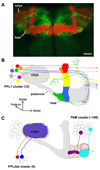Dopamine reveals neural circuit mechanisms of fly memory
- PMID: 20701984
- PMCID: PMC2947577
- DOI: 10.1016/j.tins.2010.07.001
Dopamine reveals neural circuit mechanisms of fly memory
Abstract
A goal of memory research is to understand how changing the weight of specific synapses in neural circuits in the brain leads to an appropriate learned behavioral response. Finding the relevant synapses should allow investigators to probe the underlying physiological and molecular operations that encode memories and permit their retrieval. In this review I discuss recent work in Drosophila that implicates specific subsets of dopaminergic (DA) neurons in aversive reinforcement and appetitive motivation. The zonal architecture of these DA neurons is likely to reveal the functional organization of aversive and appetitive memory in the mushroom bodies. Combinations of fly DA neurons might code negative and positive value, consistent with a motivational systems role as proposed in mammals.
Copyright © 2010 Elsevier Ltd. All rights reserved.
Figures



Similar articles
-
Distinctive neuronal networks and biochemical pathways for appetitive and aversive memory in Drosophila larvae.J Neurosci. 2009 Jan 21;29(3):852-62. doi: 10.1523/JNEUROSCI.1315-08.2009. J Neurosci. 2009. PMID: 19158309 Free PMC article.
-
Sequential use of mushroom body neuron subsets during drosophila odor memory processing.Neuron. 2007 Jan 4;53(1):103-15. doi: 10.1016/j.neuron.2006.11.021. Neuron. 2007. PMID: 17196534 Free PMC article.
-
Memory Elicited by Courtship Conditioning Requires Mushroom Body Neuronal Subsets Similar to Those Utilized in Appetitive Memory.PLoS One. 2016 Oct 20;11(10):e0164516. doi: 10.1371/journal.pone.0164516. eCollection 2016. PLoS One. 2016. PMID: 27764141 Free PMC article.
-
Reinforcement signalling in Drosophila; dopamine does it all after all.Curr Opin Neurobiol. 2013 Jun;23(3):324-9. doi: 10.1016/j.conb.2013.01.005. Epub 2013 Feb 5. Curr Opin Neurobiol. 2013. PMID: 23391527 Free PMC article. Review.
-
Roles of feedback and feed-forward networks of dopamine subsystems: insights from Drosophila studies.Learn Mem. 2024 Jun 11;31(5):a053807. doi: 10.1101/lm.053807.123. Print 2024 May. Learn Mem. 2024. PMID: 38862171 Free PMC article. Review.
Cited by
-
Parkin Knockdown Modulates Dopamine Release in the Central Complex, but Not the Mushroom Body Heel, of Aging Drosophila.ACS Chem Neurosci. 2023 Jan 18;14(2):198-208. doi: 10.1021/acschemneuro.2c00277. Epub 2022 Dec 28. ACS Chem Neurosci. 2023. PMID: 36576890 Free PMC article.
-
Taking a new look at how flies learn.Elife. 2014 Aug 19;3:e03978. doi: 10.7554/eLife.03978. Elife. 2014. PMID: 25139957 Free PMC article.
-
The Role of the Dopamine Transporter in the Effects of Amphetamine on Sleep and Sleep Architecture in Drosophila.Neurochem Res. 2022 Jan;47(1):177-189. doi: 10.1007/s11064-021-03275-4. Epub 2021 Feb 25. Neurochem Res. 2022. PMID: 33630236 Free PMC article.
-
Spermidine Suppresses Age-Associated Memory Impairment by Preventing Adverse Increase of Presynaptic Active Zone Size and Release.PLoS Biol. 2016 Sep 29;14(9):e1002563. doi: 10.1371/journal.pbio.1002563. eCollection 2016 Sep. PLoS Biol. 2016. PMID: 27684064 Free PMC article.
-
Layered reward signalling through octopamine and dopamine in Drosophila.Nature. 2012 Dec 20;492(7429):433-7. doi: 10.1038/nature11614. Epub 2012 Oct 28. Nature. 2012. PMID: 23103875 Free PMC article.
References
-
- Joshua M, et al. The dynamics of dopamine in control of motor behavior. Curr Opin Neurobiol. 2009;19:615–620. - PubMed
-
- Dayan P, Balleine BW. Reward, motivation, and reinforcement learning. Neuron. 2002;36:285–298. - PubMed
-
- Wise RA. Dopamine, learning and motivation. Nat Rev Neurosci. 2004;5:483–494. - PubMed
-
- Montague PR, et al. Computational roles for dopamine in behavioural control. Nature. 2004;431:760–767. - PubMed
Publication types
MeSH terms
Substances
Grants and funding
LinkOut - more resources
Full Text Sources
Medical
Molecular Biology Databases

